Novation Peak Review – A New Peak in Sound?
The Novation Peak stole the show at this year’s Superbooth. Andy Jones reviews this hybrid synth with digital control and effects, but very much an analogue heartbeat and sound… Novation Peak – Details Manufacturer Novation Price £1,250 (street) Contact Novation – 01494 462246 Web www.novationmusic.com The Novation Bass Station II was released about four years ago, […]
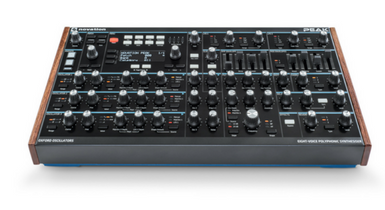
The Novation Peak stole the show at this year’s Superbooth. Andy Jones reviews this hybrid synth with digital control and effects, but very much an analogue heartbeat and sound…


Novation Peak – Details
Manufacturer Novation
Price £1,250 (street)
Contact Novation – 01494 462246
Web www.novationmusic.com
![]()
The Novation Bass Station II was released about four years ago, just at the point when hardware synths truly came back in vogue – perfect timing on Novation’s part, as it turned out. It was, and still is, a magnificent little beast and for £399, well and truly put hardware back in the line of sight for people willing to spend that on a plug-in instrument.
At the time, there was a rumour – possibly started by me – that an eight-voice version would be next. It made sense, after all. Four years down the line and we now have Peak. To be fair, it’s not really an eight-voice Bass Station, but it does share much of that synth’s heritage and sound.
Chris Huggett, the man behind the Wasp, the OSCar and Bass Station was a design consultant on Peak and, as we’ll see, there’s a big analogue sound here, although with more digital input at its heart than Bass Station had.
The signal path on the Novation Peak starts with the (digital) Oxford Oscillators – or ‘analogue sounding’ NCOs (Numerically Controlled Oscillators) – which Novation says run at such a high clock rate that you’d be hard pressed to tell them apart from true analogue oscillators. There are three of these (plus noise and ring mod) per voice, and a maximum of eight notes of polyphony, depending on the voices used per sound.
The signal path takes a true analogue route through overdrive, filter and distortion sections and the effects are pure digital, so you can see we have something of a hybrid synth on our hands, albeit one that screams analogue in terms of sound and looks. The price point is high – or at least you might consider it that – but there’s a lot of hardware with specs similar to these for a lot more money, so let’s see how Peak competes.
Peak in Practice
Unboxing the Novation Peak, we have a solid desktop unit that feels like a great-quality product. The 40-plus rotaries feel good, not too loose, and have centre reference points on suitable parameters (coarse and fine tune, for example). It’s very well designed throughout, with a logical layout, so you get the main controls and screen top left and the signal flow of the synth engine starts from oscillators through to effects flowing left to right (wth the two LFOs top right).
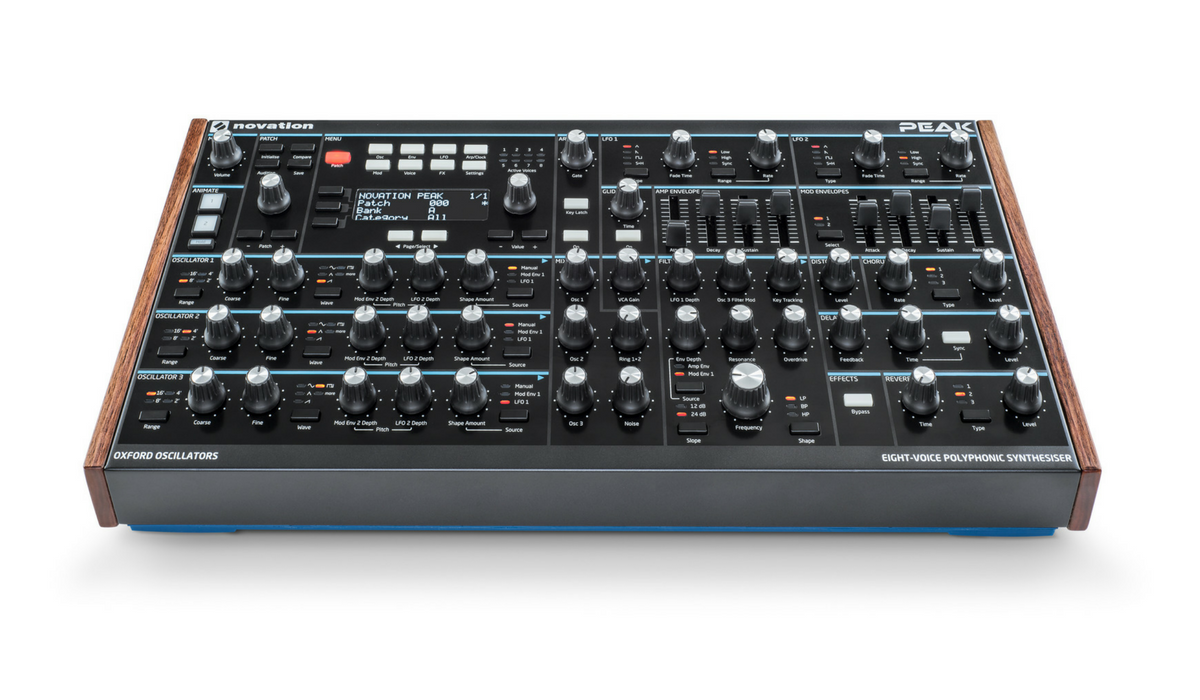
The Novation Peak is sadly not angled for desktop use, so sits rather flatly – although this doesn’t detract too much from screen or control visibility. The racks shown in the main picture do not come with Peak, which is a shame, as they look very cool and angling it as shown makes it much better to control (I put Peak on some books to angle it).
So, to the synth engine of the Novation Peak itself and we have those eight voices, each with three oscillators, ring mod and noise sources. With the oscillators, you can choose from four standard waveforms and then a further 17 that include some fairly obvious Random and Chord waveforms; some instrument-based ones (Electric Piano, String, Organ and so on); plus some which are less obvious (Harsh, Wobbler and Tubey). Tubey, for example, adds a slight distorted effect, while Octaves pitches things up and Zing seems to bring the upper mids through for more presence.
On the far left of the Oscillator section, you get range options that utilise an organ draw-bar method to quickly transpose your octave (16 being the lowest, 2 being the highest).
There are coarse and fine-tune rotaries, the aforementioned Waveform select buttons and then dials to adjust how the frequency of each oscillator is modulated by both Mod Env 2 and LFO 2 Depths. Interestingly, you can also modulate all three oscillators simultaneously with LFO 1 as part of the extensive modulation options that Peak has – more on these shortly.
Finally in the Oscillator section, a Shape amount dial can be adjusted manually or set to be modulated by either the Mod Env 1 or LFO 1 sources. Select a Square wave on your LFO 1 and a low rate to hear this dramatic octave up and down action and gradually increase the rate and the sustain on the Mod Envelope for some tearing analogue sonic action.
It’s credit to the designers that the Oscillator section is both straightforward and detailed. There’s a lot to mess with your sound at source, but it’s pretty easy to get your head around what is modulating what, because the screen works so well in the context of what you are doing. As you work with the synth, the screen latches onto whatever you are dialling to show the change in parameter value, so you can clearly see what is going on.
The cool thing is that after you have edited a dial elsewhere, the screen reverts back to whatever section of the synth you have selected above the screen (from eight options).
So, for example, I was stepping through the waveforms for Oscillator 2, made a quick change to the Fade Time on LFO 1 to see what it did (it adjusts how long it takes for the LFO to get in gear) and then the screen reverted back to the Oscillator 2 function automatically, as I had the Osc button lit. It’s a clever process and surprisingly useful in practice, as it makes stepping to and working within different parts of the synth very intuitive.
Novation Peak Overview
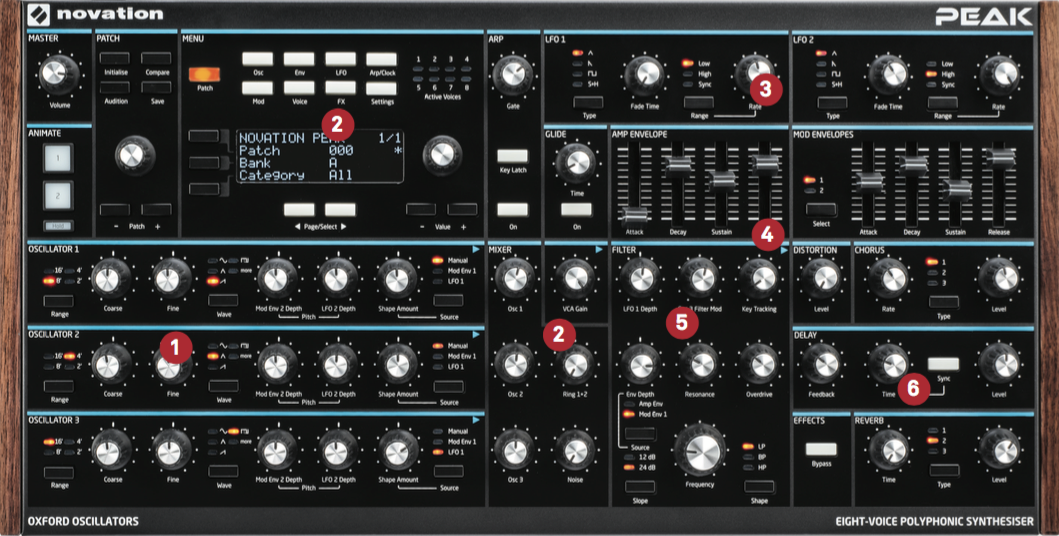
1: Sources – Three Numerically-Controlled Oscillators (NCOs). Choose Sine, Saw, Triangle, Sawtooth plus 17 wavetables. Ring Mod and noise sources are in the Mixer section
2: Main Section – The screen works well in conjunction with the select buttons above it, which latch it to an area within Peak’s architecture
3: The LFOs – With identical controls, you can choose from four waveshapes with both LFOs. However, LFO1 is generally assigned to Oscillator shape and LFO 2 to pitch
4: Three Envelopes – Peak offers a ‘standard’ ADSR Amp Envelope and two Mod Envelopes. Again, number 1 controls the oscillator shape (and filter) and 2 its pitch
5: Filter Section – Lots of options in the Filter section, with three types to choose from, plus an interesting pre-filter Overdrive option that adds oomph
6: Effects – Simple controls, maybe, but a huge and varied sound can be applied to any of Peaks patches with these digital effects
LFO with the Flow
We’ve touched on the two LFOs and what they modulate already and their controls are identical – four types to choose from over three ranges and dials for Fade Time and Rate. But just to reiterate, LFO 1 modulates the shape of each oscillator (when selected as the source) and LFO 2 modulates the pitch for a vibrato effect. LFO 1 will also modulate the filter frequency.
Within the mixer section, as well as adjusting these three oscillators’ levels, you can bring some dirt in with both noise and Ring Mod options. Linked to the Mixer section, the Envelope area allows you to control the note Attack, Decay, Sustain and Release (ADSR )values – how a note’s volume changes over time.
There are two additional mod envelopes, too. Again, number 1 applies its envelope to the shape amount of each oscillator and also the filter frequency. Mod Env 2 modulates the pitch of each oscillator. So the Peak rule is simple, really: 1= shape, 2 = pitch!
The Filter section has loads of options. Choose between LP, BP and HP types and adjust the overall frequency and resonance. You can choose between a 12 and 24dB slope, which determines how steeply the filter rejects or allows frequencies to pass (24 is steeper, so more severe in action).
Again, we’ve touched on the modulation options. The filter frequency can be modulated by a combination of LFO 1, the Amp Env and Mod Env sections (with a switch selecting either of the latter two).
To finish off my overview, there are a number of effects. The Overdrive control works pre filter and the Distortion dial post filter, but they’re both within the analogue signal path, so add lots of power and crunch respectively when needed.
Three further effects – chorus, delay and reverb – add some incredible drama to the overall sound. They’re digital, but the reverb especially is astonishing – set at maximum, it just goes on forever. There are simple controls to select each effect, with three types for both reverb and chorus, three Level rotaries and a handy Sync option for the delay.
And There’s More
If you think that’s a lot of modulation and that the ‘science bit’ is over, think again, because Peak comes with a whole Modulation Matrix area – selected by the Mod button just above Peak’s screen. In case you don’t know, a Modulation Matrix is where you can select a source on a synth – LFO 1 or the mod wheel, for example – and get it to affect or modulate a destination (ie, the pitch or shape of an oscillator).
Peak’s Matrix has 16 sources (plus CV input) and 37 destinations. That is an incredible number to have, especially given you can have 16 different ‘Slots’ (or combinations) of these set up at any one time. For any of these 16 Slots, you can have two sources modulating one specific destination, with the sources multiplying their effect together. If you want several Slots all modulating the same destination, you can do that, too. You’d be mad to do it, but you can…
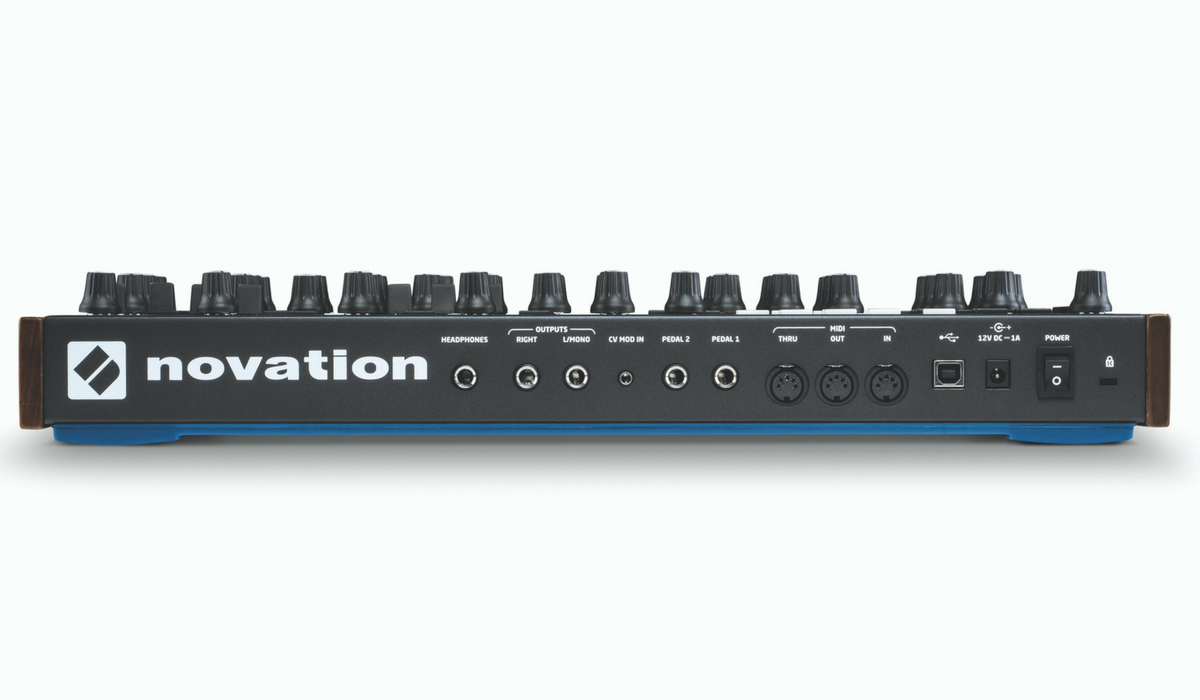
Lots of connections around the back, including CV Mod In and a full suite of MIDI and audio
And while it would be great to have a kind of Battleships physical-peg matrix on the synth (as Arturia has with its MatrixBrute) Novation has made the process incredibly simple. Simply select a Slot from 16, your two sources and one destination, plus the depth of each one – and the screen makes this very easy to do – and you’re there.
Okay, okay, I’ve modulated long and hard now, I know that. But it’s important to get across that you get loads of these options available on the top layer of Peak and then a whole world of others just beneath the surface. It’s really the heart and soul of the synth, is also why and why it sounds so good. Oh yes, how it sounds…
Alternatives
I’ve reviewed some incredible Dave Smith synths over the last couple of years and it’s testament to Peak that I’m putting these in as alternatives. The OB-6 and Prophet-6 are true out-and-out analogue synths with digital effects and they both sound incredible.
However, with the UK pound getting a kicking in the exchange rates, you’d be hard pressed to get either for less than a couple of grand (in the OB-6’s case, it’s well over). I’m not mentioning the Teenage Engineering OP-1 as an alternative – it’s nothing like Peak – but I bloody love it! The Moog Sub 37 is also a synth that I tested and has real character and similar sounds.
It’s around the same price as Peak and comes with a keyboard, but lacks the polyphony. Dave Gale tested the Arturia MatrixBrute I mentioned in the main text and that is a monster synth, with that plug ’n’ play 16×16 matrix. But it does weigh in at £1,750; way more than Peak. So while Peak is expensive for a Novation product, in its respective marketplace, Novation has come in with a reasonable price for it after all.
Peak in Sound
Stepping through the 256 presets (there’s room for another 256 of your own) and you soon realise that this is a synth’s synth. By that, I mean that it goes for the synthetic jugular with a set of crowd-pleasing sounds that you’d expect from an analogue beast.
So less on the emulating acoustic instruments front, thank you very much, and more in the way of squelchy basses, racing arpeggiations, dreamy pads and cutting leads. All of those are here in abundance and rather great they are, too.
You may initially think that all of that modulation I’ve been banging on about isn’t that evident on more of the onboard sounds. There are so many options beneath Peak’s bonnet that I expected to hear more movement and more bonkers-ness up front in the first bank. But don’t fret, as there is some on display, just later in Bank B (‘Plankton 1’ and ‘Its Brave 2 Hold’).
I think Novation has led with the synthier ‘normal’ stuff, which is no surprise, and what we get here is often sublime. The atmospheric stuff is instantly inspiring – check out ‘VHS Pad’, ‘Relax (Autoplay)’ and ‘Fema’ and, as I said, there’s plenty of bombastic stuff for EDM producers everywhere (‘Dark Bark’, ‘Temple’ and ‘Sprinkler’).
What I also really like about Peak is that you’re never more than a couple of twists away from dirtying something up. Of course, the Noise source is great for this, but so too are the Distortion and Overdrive dials – they really can mess something up… nicely!
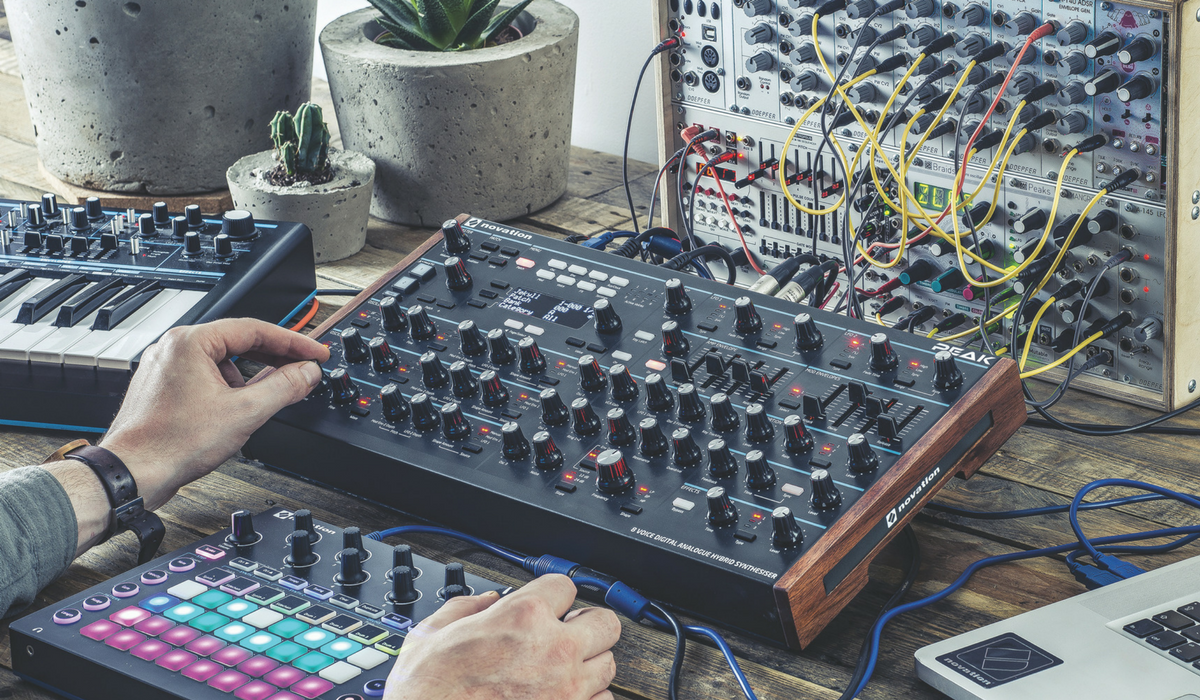
MIDI and CV connections allows Peak to be part of your Modular world
And the effects are a great addition, too. I’m stunned at how good the reverb is. Put it on maximum time and level and you have a tail that dreams on and on – instant ambience. The delay really does add a lot to many presets, too – again, very simple, but effective.
I also like the Animate option, too, first seen on the Nova range. Press either button during an arpeggiation – a sound like the ‘Running Man’ preset – and each button modulates a different parameter, so ‘animating’ the sound somewhat, giving it a different emphasis, effect or, say, more bottom end. It’s a great option for performing with and adding variation.
Conclusion
Overall, then, that is a great set of varied sounds from a machine that is full to the brim with features and options. The sound that the Novation Peak makes can be totally analogue if you want it to be and totally off the wall, too – it is incredibly flexible.
Novation always seems to price its products competitively in whatever markets they are in, and while Peak is more expensive than any other Novation product, you could argue that the company has again priced it well. That’s because it sits within a high-end synth market in which you could easily spend a couple of grand on a synth with this much power, so in that sense, it could be seen as a bit of a bargain.
The Novation Peak has excellent and varied sounds and effects and more than enough options to synthesise, create and modulate your own. It’s years of fun and creativity in one box.
Novation Peak key features
- Hybrid synth
- 8-note polyphony
- Monotimbral
- 512 presets (with 256 user)
- Sources: 8 voices each with 3 oscillators, noise and ring mod
- 1 filter, 2 LFOs, 1 amp and 2 mod envelopes/voice
- Chorus, delay and reverb
- 3 filter types with pre-overdrive, post-distortion
- Huge modulation options
- Size: 233 x 464 x 70.3mm
